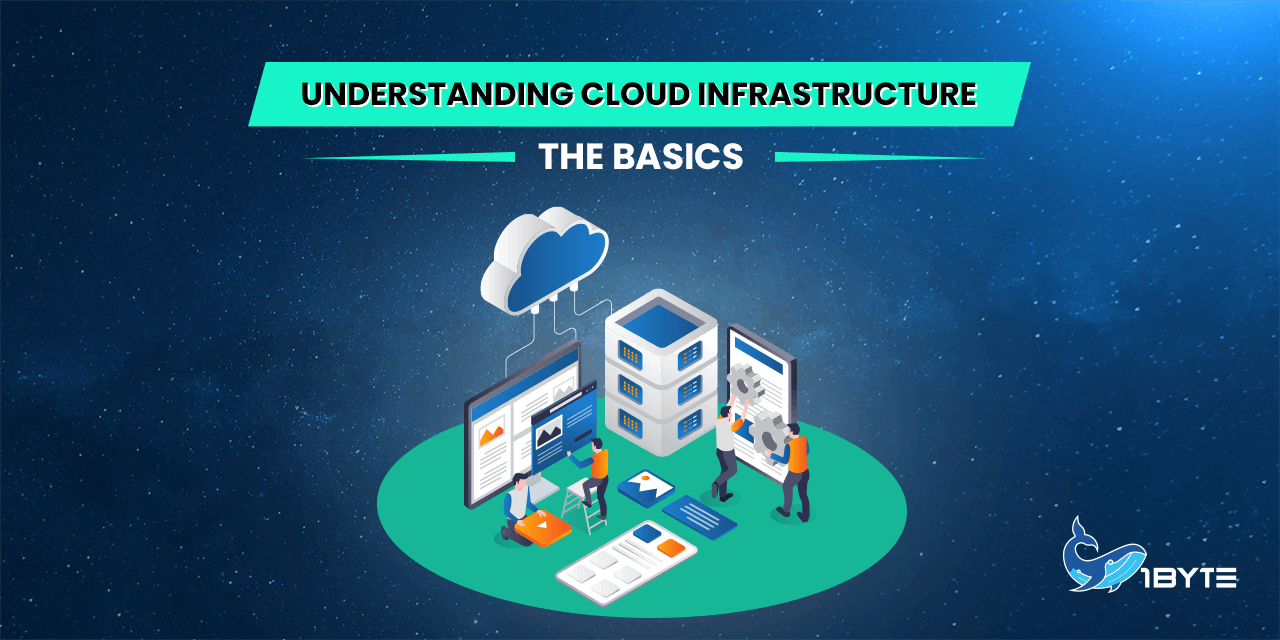This post will equip you with the required knowledge to comprehend cloud infrastructure and its components, whether you are a business owner, developer, or simply a curious individual. In this post, we will define cloud infrastructure, discuss its merits, and explain how it works. In addition, we’ll go over the various forms of cloud infrastructure and their applications. By the end of this article, you’ll have a firm grasp on cloud infrastructure and its significance in today’s technologically driven world.
An Overview
In this section, we’ll take a general look at cloud infrastructure and the technology that powers it.
FURTHER READING: |
| 1. Cloud Migration Strategy: A Step-by-Step Guide |
| 2. Colocation vs Dedicated Server Hosting: Which Option Is Right for You? |
| 3. What Is a Dedicated Server? All You Need to Know |
What is Cloud Infrastructure?
A cloud infrastructure is a network of virtualized servers, storage, and networking resources that allow cloud computing services to function. This infrastructure is designed to be flexible, scalable, and cost-effective, and it can be accessed and operated via the internet.
Cloud infrastructure is made up of several servers and storage devices that are interconnected and work together to provide users with processing power and storage capacity. It is an ideal alternative for enterprises that need to manage variable workloads because these resources can be readily scaled up or down depending on the user’s needs. The underlying physical infrastructure that underpins cloud computing services is often owned and managed by cloud service providers such as Amazon Web Services (AWS), Google Cloud Platform (GCP), and Microsoft Azure.
Cloud Infrastructure Trends
As cloud technology evolves, so do the trends and best practices for cloud infrastructure. Here, we will look at some of the most recent developments and advancements in cloud infrastructure, as well as what organizations can expect in the near future.
Emerging Cloud Infrastructure Technologies
Cloud infrastructure is growing in popularity as companies look to the cloud to maintain their systems up to date with the latest technologies. Multi-cloud/hybrid cloud solutions, serverless computing, and containerization are some of the emerging cloud infrastructure technologies.

Multi-cloud/hybrid cloud systems combine features and functionalities from public cloud platforms with private cloud solutions. Serverless computing, on the other hand, is a novel approach to developing and running applications that does not require the use of servers. Instead, the cloud provider handles all infrastructure concerns. Finally, containerization is a technology that enables developers to consistently and reliably package and distribute applications.
To remain competitive, organizations will need to adopt new cloud infrastructure technologies as they continue to shift to the cloud. Businesses may ensure they are taking advantage of the newest improvements in cloud computing by keeping up with these emerging technologies. Businesses can use these technologies to increase productivity, cut costs, and improve overall performance.
Increasing Adoption of Multi-Cloud
Nowadays, most businesses use cloud infrastructure, with Amazon Web Services being the most popular. Recent research, however, shows that many businesses are increasingly using several public clouds, with 73% of firms using two public clouds and 26% using three or more. This is known as multi-cloud, and it allows enterprises to use several cloud services from various providers.
According to Grandview Research, the Cloud Computing Market is expected to reach $1251.09 billion by 2028, with a CAGR of roughly 19.1% between 2021 and 2028 for cloud technology. Enterprises are also beginning to use hybrid and multi-cloud solutions. According to Flexera, 87% of businesses have adopted a hybrid cloud strategy, while 93% have adopted a multi-cloud strategy. Companies use 2.2 private clouds and 2.2 public clouds on average.
Furthermore, Gartner research predicts that by 2025, more than 95% of enterprises will be using cloud technology, and 95% of data workloads would be hosted in the cloud, up from 30% in 2021. According to Zippia, cloud spending in the United States is predicted to exceed $90 billion by the end of 2022.
However, it is important to highlight that 80% of businesses have had at least one cloud security event in the last year, with cloud-based breaches accounting for 45% of all breaches. As a result, while implementing cloud technology, it is critical to implement strong security measures to assure data privacy and protection.
How Cloud Infrastructure Works
Cloud infrastructure is a critical component of modern technology that has transformed the way data is stored, processed, and managed. This section explains how cloud infrastructure works and the essential components that go into it. Cloud infrastructure is, at its core, a collection of networked servers, networks, and storage devices that collaborate to provide computing resources over the internet. These resources include processing power, storage space, and software applications that can be accessed and used by people from anywhere in the globe who have access to the internet. Understanding how this complicated system works is critical for anyone wishing to use cloud computing for personal or corporate purposes.
Overview of the cloud infrastructure architecture
The different components that comprise a cloud computing system are referred to as cloud infrastructure architecture. The front end and the back end are the two fundamental components of cloud infrastructure architecture. The client’s devices, such as computers, mobile phones, and tablets, are referred to as the front end. The cloud’s back end consists of servers, data storage systems, and other infrastructure.
The front end is in charge of how the user interacts with the cloud system. Users connect with the cloud using a user interface, which could be a web browser or a mobile app. Users can utilize the user interface to access the cloud’s services and resources. The back end, on the other hand, consists of the physical components that power the cloud, such as servers, data storage systems, and networking equipment.

The back end is in charge of managing the resources that users can access via the front end. The cloud provider’s data centers, where servers and other hardware are housed, are included in the back end. These data centers store and process data while also providing access to various computer services like virtual machines, storage, and networking.
The design of cloud infrastructure can be deployed in a variety of ways, including public cloud, private cloud, and hybrid cloud. Third-party cloud providers operate public clouds, which give services to many clients via the internet. Private clouds, on the other hand, are managed by a company or organization for internal usage. Hybrid clouds are a combination of public and private clouds that provide the advantages of both.
Types of cloud infrastructure models
There are three basic types of cloud infrastructure models that are regularly employed. The first is the public cloud model, which is run by a third-party cloud service provider and provides users with infrastructure resources such as servers and storage via the internet. Because public cloud infrastructure is often less expensive and more adaptable than traditional IT infrastructure, it is an appealing alternative for startups and small businesses.
In contrast, private cloud infrastructure is dedicated to a particular enterprise and is frequently hosted on-premises or in a private data center. Although private cloud infrastructure provides greater control over data and security, it is more expensive to operate and needs a larger initial investment.
Finally, there is the hybrid cloud model, which mixes public and private cloud infrastructure, allowing businesses to reap the benefits of both while keeping control over sensitive data.
Examples of cloud infrastructure providers
Cloud infrastructure providers enable organizations and people to gain online access to computing resources such as servers, storage, and software applications. The supplier manages these resources and makes them available to clients on demand.
Amazon Web Services (AWS) is a well-known cloud infrastructure company. AWS provides a variety of cloud-based services, such as computing power, storage, and databases. As of 2022, AWS controls 34% of the cloud infrastructure industry.
Microsoft Azure is another prominent provider of cloud infrastructure. Azure offers a variety of cloud services, such as compute, storage, and analytics. Azure controls 20% of the cloud infrastructure industry as of 2022.
Google Cloud Platform (GCP) is a cloud infrastructure provider that provides computing, storage, and networking services. GCP is well-known for its sophisticated machine learning capabilities, and it controls 10% of the cloud infrastructure market,
IBM Cloud, Oracle Cloud, and Alibaba Cloud are some of the other cloud infrastructure providers. Because each provider has various services and pricing strategies, it’s critical to research and compare providers to find the greatest fit for your specific needs.
Recommended reading: Cloud Migration Strategy: A Step-by-Step Guide
4 Benefits of Cloud Infrastructure
In this section, we’ll look at some of the key advantages of cloud infrastructure that are making it an increasingly popular choice for enterprises of all kinds. Cloud infrastructure has numerous benefits that traditional on-premises infrastructure cannot match, including cost reductions, scalability, flexibility, and security. Understanding these advantages is critical for making an informed choice about whether cloud infrastructure is a good fit for your organization’s needs. So, let’s get started and look at the advantages that cloud infrastructure can offer your company.
Scalability and Flexibility
Scalability and flexibility are two important advantages of cloud infrastructure that have changed the way enterprises operate. Scalability refers to a system’s ability to handle growing workloads by adapting and expanding its resources to meet the demand. This skill enables firms to respond more quickly to market shifts, consumer needs, and unexpected events without incurring additional costs.
Flexibility, on the other hand, refers to the ability to configure a system to meet individual demands. It enables organizations to pick and choose whatever services and features they need, pay only for what they use, and make changes quickly and easily. As a result, companies can be more agile, innovative, and quick to adapt to market opportunities and difficulties.
Cost-effectiveness
One of the most major benefits of cloud infrastructure is its low cost. Companies must make a considerable upfront commitment to purchase and maintain hardware and software with traditional on-premises infrastructure. Cloud infrastructure providers, on the other hand, provide a pay-as-you-go approach in which users only pay for the resources they use on a per-minute or per-hour basis. This enables businesses to scale up or down as needed without worrying about the overhead costs of maintaining and upgrading their gear and software.

Furthermore, cloud infrastructure providers can attain economies of scale, which allows them to offer their services at a lower cost than businesses could on their own. Because cloud providers may spread the expense of infrastructure and maintenance across their entire user base, individual consumers can benefit from lower rates.
Furthermore, cloud infrastructure allows businesses to avoid the high expenses of downtime. Downtime can cost you money, productivity, and customer confidence. Companies using cloud infrastructure can reduce the risk of downtime by leveraging the provider’s high availability and disaster recovery capabilities, which are frequently included in the service.
High Availability
High availability is one of the most major advantages of cloud infrastructure. Your application or website can stay operational in the case of a server outage, hardware failure, or other interruptions with cloud infrastructure. This is due to the fact that cloud providers use redundancy to ensure that your data and apps are stored in different places, allowing for speedy failover in the event of a problem.
Automatic load balancing is also provided by cloud architecture, which distributes traffic evenly across numerous servers, ensuring that no single server is overburdened. This helps to avoid downtime and ensures that your application is always available to users.
Another benefit of high availability in cloud architecture is that it allows enterprises to simply scale up or down their resources as needed. For example, if your website or application experiences an increase in traffic, the cloud infrastructure may instantly provide additional resources to manage the increased load. This is especially beneficial for firms with changing demand because it avoids the need to invest in additional gear that may not be required all of the time.
Security and Disaster Recovery
The level of security provided by cloud infrastructure is one of its most significant advantages. Data is stored in highly secure data centers with many layers of physical and virtual security mechanisms in place, such as firewalls, encryption, and intrusion detection systems, while using cloud infrastructure. Furthermore, cloud infrastructure providers employ dedicated security teams to continuously monitor and improve the security of their systems while adhering to industry norms and regulations.
Cloud infrastructure provides robust disaster recovery alternatives in the event of a disaster or outage. Businesses may rapidly and easily transfer their data and apps to another location using cloud-based disaster recovery solutions, maintaining business continuity and minimizing downtime. Cloud infrastructure providers also provide geographically scattered data centers, allowing for redundant data storage in several places, enhancing data security and availability even further.
Challenges of Cloud Infrastructure
Challenges are an inherent part of any technology, and cloud infrastructure is no exception. Despite its numerous benefits, cloud infrastructure also has some challenges that organizations must consider before moving to the cloud. In this section, we will explore some of the most significant challenges that organizations face when using cloud infrastructure. We will discuss how these challenges can impact an organization’s operations and what steps can be taken to address them. It is essential to understand these challenges so that organizations can make informed decisions and ensure the smooth functioning of their cloud infrastructure.
Integration Challenges
Integrating numerous systems and applications with cloud infrastructure might be difficult. This is due to the fact that each system may have its own set of protocols and data formats that must be harmonized. Furthermore, applications may not be built to work together.
Data synchronization is a typical integration difficulty. distinct programs may demand distinct data formats and may store data in different formats. This can result in data inconsistencies between systems. To address this issue, data integration technologies and approaches that ensure data synchronization across applications might be deployed.
Another issue is the lack of standardization in application programming interfaces (APIs). APIs allow apps to communicate with one another. However, if APIs are not standardized, system integration can be challenging. To address this issue, businesses can create their own APIs or use third-party APIs built to interact with various platforms.
Furthermore, security can be a concern during integration because combining systems can introduce new vulnerabilities. When integrating systems, it is critical to ensure that security measures to protect against cyber attacks are in place. This includes putting in place access controls, encrypting data, and keeping an eye out for unusual behaviors.
Network Latency and Bandwidth
When employing cloud infrastructure, enterprises may encounter two key challenges: network latency and bandwidth.
Latency is the time it takes for data to be sent over a network. When using the cloud, data must flow from the cloud server to the end-user’s device. Latency might become an issue if the distance between the server and the user is large. As a result, application performance may suffer and the user experience may suffer.
Bandwidth is the quantity of data that can be moved through a network in a given amount of time. When several users request cloud resources at the same time, bandwidth can constitute a bottleneck. As a result, data transfer rates may slow and network congestion may increase.
Organizations can solve these problems by implementing solutions such as deploying content delivery networks (CDNs) to minimize latency and enhance bandwidth. Furthermore, cloud providers may provide services that enable closer proximity to end users, minimizing the distance data must travel.
Data Security and Privacy
Organizations that employ cloud infrastructure are concerned about data security and privacy.
Data saved in the cloud is frequently accessed from numerous places and devices. This raises the possibility of illegal access and data breaches. Furthermore, cloud providers may be subject to different rules and regulations than the company that is using the cloud, which can make assuring compliance with data privacy regulations difficult.

Organizations can address these concerns by using various security measures such as data encryption, access controls, and monitoring for suspicious activities. To assist enterprises in protecting their data, cloud providers may also provide security services such as firewalls and intrusion detection systems.
Before picking a cloud provider, enterprises must thoroughly analyze their security and privacy capabilities. Considerations include data encryption, access controls, and compliance with data privacy legislation.
Vendor Lock-in
Another key difficulty that enterprises encounter when employing cloud infrastructure is vendor lock-in.
Vendor lock-in occurs when an organization becomes dependent on the services of a certain cloud provider and is unable to readily transition to a new provider. This might occur owing to variables such as proprietary APIs or data formats that make switching to another source difficult.
Vendor lock-in can be expensive and hinder an organization’s ability to adapt to changing business needs or take advantage of better pricing or features offered by competing cloud providers. To minimize vendor lock-in, businesses should adopt open standards and open-source software, which makes switching between cloud providers easier.
When selecting a cloud provider, enterprises must evaluate the possibility of vendor lock-in. This involves assessing the provider’s support for open standards as well as compatibility with other cloud providers.
Leverage 1Byte’s strong cloud computing expertise to boost your business in a big way
1Byte provides complete domain registration services that include dedicated support staff, educated customer care, reasonable costs, as well as a domain price search tool.
Elevate your online security with 1Byte's SSL Service. Unparalleled protection, seamless integration, and peace of mind for your digital journey.
No matter the cloud server package you pick, you can rely on 1Byte for dependability, privacy, security, and a stress-free experience that is essential for successful businesses.
Choosing us as your shared hosting provider allows you to get excellent value for your money while enjoying the same level of quality and functionality as more expensive options.
Through highly flexible programs, 1Byte's cutting-edge cloud hosting gives great solutions to small and medium-sized businesses faster, more securely, and at reduced costs.
Stay ahead of the competition with 1Byte's innovative WordPress hosting services. Our feature-rich plans and unmatched reliability ensure your website stands out and delivers an unforgettable user experience.
As an official AWS Partner, one of our primary responsibilities is to assist businesses in modernizing their operations and make the most of their journeys to the cloud with AWS.
Conclusion
To summarize, cloud infrastructure is a fundamental component of modern computing that allows customers to access computational resources on demand. As more firms utilize cloud infrastructure, it’s critical to understand the benefits and drawbacks of this technology.
Cloud infrastructure provides scalability, flexibility, and cost-effectiveness, but it also has drawbacks, including network latency and bandwidth, data security and privacy, and vendor lock-in. To overcome these obstacles, organizations must carefully select their cloud infrastructure provider, implement effective security policies, and retain control over their data. Overall, cloud infrastructure has transformed the way organizations approach computing, and it will continue to play an important part in many industries’ digital transformation in the coming years.

